JARS v63n2 - Phytophthora ramorum and kernoviae
Phytophthora ramorum and kernoviae
Ian Wright
Garden Adviser to The National Trust in England, UK.
Since 2003 a new threat has appeared in UK gardens, the full implications are not yet fully understood but which we do know has the potential to be very damaging to our woody plant collections. Some of the initial discoveries of Phytophthora ramorum (PR) were along the west coast of the USA in the 1990s, but the actual natural origins of the disease are not yet known. A close relation is our own UK version of PR, which is devastating the UK's native Tan Oak ( Lithocarpus densiflorus ) population and introduced Northern American oak species ( Quercus agrifolia (Coast live oak) and Q. kelloggii for example), as well as potentially many other woody plant species. Although rightly being widely referred to as 'Sudden Oak Death' (due partially to the highly susceptible nature of Tan Oaks) in the United States, our own UK Oak species (different species with thicker, more protective bark) have not been affected on the same scale as in the USA and this common name has led to some confusion in the UK. Hence, I will refer to these diseases by their longer Latin names below.
The UK and US types of the pathogen are known to be different from each other. The UK population of PR is slightly more aggressive (possibly due to the different plant communities present there) than its American counterpart, grows faster, is more stable and is comprised largely of the A1 Mating Type. The American population of PR has slightly slower growth and is comprised uniquely of the A2 Mating Type. If the two populations come into contact with one another and are able to sexually reproduce, they may have the potential to create long-lived spores called oospores, which then opens up the possibility of greater genetic variation in the future, with the progeny possibly even more aggressive than the parent types.
P. ramorum was first noted in the UK during 2003, and was initially found mainly on Viburnum and Rhododendron (Figs. 1,2) in nursery situations. However, when surveys in heritage gardens and countryside situations for PR in Cornwall (a western county of England) were conducted, not only was PR identified but a new, more aggressive pathogen was also found, subsequently named Phytophthora kernoviae (PK). PK is not closely related to PR but has similar symptoms and both diseases are managed as one. The initial worry was, and indeed still is, the risk of spread and as a consequence, potential damage to native plant communities and woodlands. Recent outbreaks of these diseases on a UK native heath species, Vaccinium myrtillus (UK Bilberry), has highlighted this concern. Up until now, though, the main damage has been caused to historic plant collections and to nursery stock.
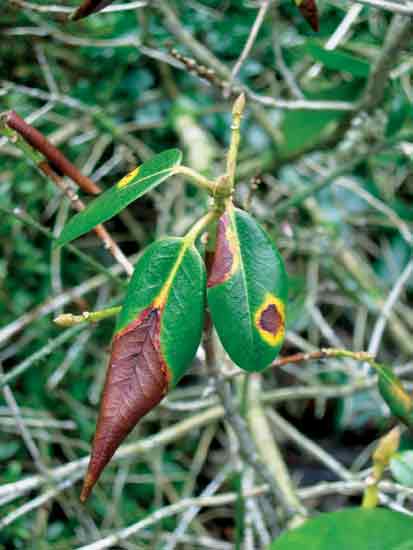
|
|
Figure 1:
P. ramorum
on
Rhododendron 'Golden Oriole'.
Photo by Ian Wright |
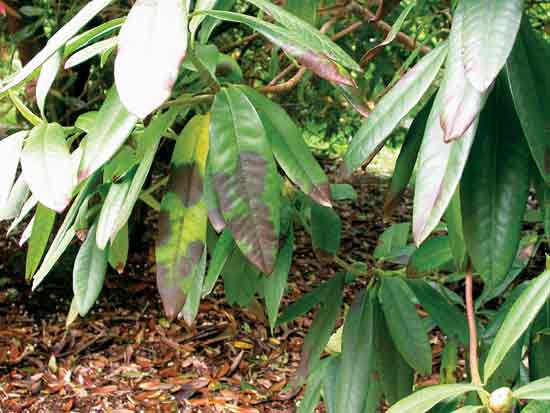
|
|
Figure 2:
P. ramorum
on
Rhododendron
sp.
Photo by Ian Wright |
What is
Phytophthora ramorum
?
Phytophthora
is a fungus-like disease pathogen, belonging to a group of organisms known as
oomycetes. Oomycetes were thought until recently to be fungi as they spore and have hyphae. However,
DNA analysis in the 1990's indicated that they were more closely related to algae groups (diatoms
and brown algae in particular). They have now been placed in a separate taxonomic kingdom 'Chromista',
which includes the algae community, as opposed to being a fungi kingdom member. Therefore,
P. ramorum
is only 'fungal like'. PR spores are aerially dispersed on water particles.
Although both PR and PK are primary pathogens and can kill a plant outright, other effects of high
inoculum (infectious propagules) levels could be the loss of beneficial microrhyzal fungi or that
any PR weakened plant would provide host opportunities for other diseases. Main sporulating hosts
occur in both the UK and USA -
Rhododendron ponticum
in the UK and Californian Bay Laurel,
Umbellularia californica
, in the USA. In the UK, reducing abundance of the huge biomass of
Rhododendron ponticum
(also a UK invasive species) should thus help reduce risk and new
outbreaks.
P. ramorum
has a complex lifecycle completed on colonised host plants. It can rapidly
reproduce asexually under favourable weather conditions, which are cool to mild temperature and
very high humidity/rain. This type of reproduction only occurs on foliage, fruit and tender shoots
of susceptible host plants. When environmental conditions are right, many microscopic sporangia,
which are lemon-shaped structures, develop on the surface of infected leaves. The contents of each
sporangium divide to form about 20 motile zoospores that are released from the sporangium in wet
conditions. Zoospores can swim in a thin film of water to healthy host tissue and infect it, thus
repeating the cycle. Zoospores are therefore considered the primary form of inoculum of PR. Under
favourable conditions, such inoculum can be produced abundantly and rapidly, within hours.
The impact in ornamental gardens in the UK.
Phytophthora ramorum
and
kernoviae
have both been deemed 'introduced pathogens' in
the UK and are from an as yet unknown location. Field research trips to suspect areas has to date
not yielded any positive results as to where these pathogens occur naturally in the world. Both
pathogens are increasingly having a major impact on UK historic gardens particularly in, but not
confined to, the wetter/warmer west of the UK. A significant number of National Trust gardens
now have outbreaks. Predictions show that if 'unchecked', the pathogens presence will increase
particularly within gardens (one prediction is most UK gardens within a period of 20 years or so)
and susceptible woodland or native plant communities, spreading to all parts of the UK with
climatic conditions conducive for disease growth.
The first disease cases within National Trust (NT) gardens were in 2003, but maybe as an indication of the aggressive nature of the disease and the lack of adaptation within plant communities, within the NT there are now over 500 confirmed outbreaks in 19 gardens over a wide geographical range. Considering groups of plants, disease instances likely number well in the thousands. A number of gardens are at risk of significant damage to their Rhododendron collections, which seem to be particularly susceptible, along with many other selected woody species. The susceptibility list of species at risk from the pathogens continues to increase, therefore making it likely some gardens may lose their historic design or character if the disease is unchecked.
The Main Hosts for P. ramorum in the UK
•
Rhododendron
sp.
•
Viburnum
sp.
•
Magnolia
sp.
•
Michelia
sp.
•
Osmanthus
sp.
•
Camellia
sp.
•
Kalmia
sp.
•
Pieris
sp.
If inoculum is allowed to build up, there is the potential for a greater variety of species to become affected. Indeed, we have seen that Fagus , Lomatia , Prunus (laurels), Aesculus , Quercus ilex can all become infected, along with many other species, but usually only when a high presence of the disease occurs.
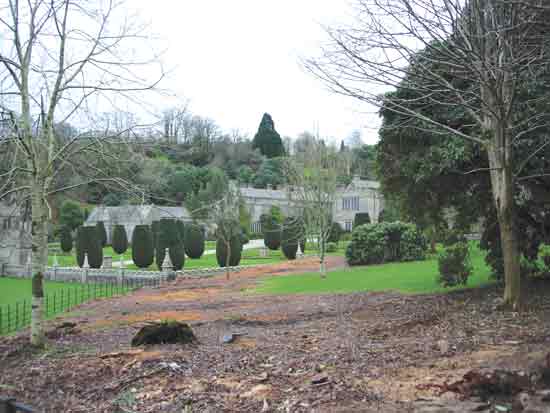
|
|
Figure 3: Loss of green screens.
Photo by Ian Wright |
In addition to obvious plant losses, loss of green screens (Fig.3), unwanted views, loss of shelter and microclimate change are all potential outcomes of infection. As disease presence is mandatory notifiable to the UK plant health inspectorate, containment or eradication notices may be issued by our UK government agency. These state that no susceptible species can be planted within a 4 metre radius of an infected plant for 3 years, which can be a challenge for gardens even in the short term!
UK-wide mapping of risk areas using temperature, rainfall, and susceptible species clearly show large parts of the western UK and some parts of the midlands and southern England high risk areas. One source of long distance disease spread is the 'pathways' created by moving nursery stock. Presence of these diseases in the nursery industry must have gone undetected for a while before extensive surveys were conducted and an understanding of them grew. Although painful financially, these diseases are easier to contain within a nursery situation then when they are confirmed in a garden or wild situation, where eradication becomes a much more difficult challenge.
Phosphonate based treatment: Agrifos/pentrebark (not yet approved for use in the UK) may be a future answer to protecting our more valuable specimens, but a required treatment program may last indefinitely.
Plant Collections
It is important we know and understand our plant collections and to manage them to promote healthy vigorous growth. Due to old age and the general health of some our more important Rhododendron collections, traditional methods of propagation may not now be successful or indeed possible. Also, if a disease outbreak is confirmed, it will not be possible to transfer green material from the garden without the permission of a government plant heath agency.
The National Trust has its own Plant Conservation Program which operates from Knightshayes Court in Devonshire to propagate and distribute the National Trust's more important specimens. In addition, the Duchy College Horticultural College at Rosewarne in Cornwall micropropagates the most valuable specimens. Micro-propagation is the production of a potentially infinite number of plants from bud or shoot tissues in a controlled solution, usually within a laboratory environment. To date, the college has had considerable success with the micro-propagation process and, once growing, the infection-free material itself can be infinitely propagated and then passed on to the other propagation unit at Knightshayes with no real future need to return to the parent plant in the garden of origin. The hope is that enough plants can be produced to distribute to other infection free gardens with similar growing conditions.
The importance of doing this work can be highlighted by many examples, but one that comes to mind is Rhododendron macabeanum (Fig.4, KW7724, which flowered for the first time at Trengwainton (a National Trust property) from material brought back by Frank Kingdon-Ward from his plant hunting expeditions to Assam and the Mishmi Hills in upper Burma in 1927-8. It was awarded a First Class Certificate from the R.H.S in 1938. The original plant is under threat from both PR and PK. This species is widely available but not with the specific plant this pedigree has because of its strong links to the collector and source.
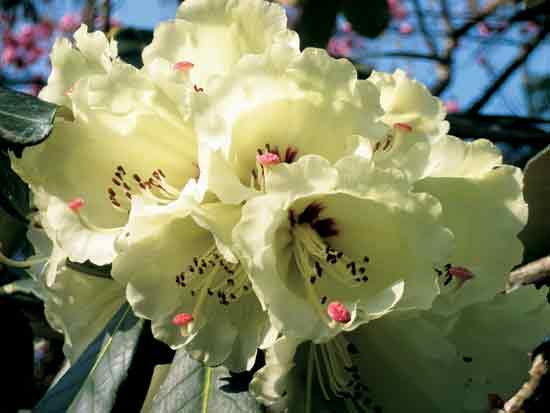
|
|
Figure 4:
Rhododendron
macabeanum
Photo by Ian Wright |
Micropropagation
The traditional propagation procedure within the National Trust is via the Plant
Conservation Programme at the nursery located at Nightshayes Court in Devonshire,
but this route is difficult when infection is confirmed. A restriction is then
placed on infected gardens by the UK Department for Environment, Food and Rural
Affairs (DEFRA) to limit the movement of green/plant material. As a consequence,
we have been working with Duchy College at Rosewarne in Cornwall to micropropagate
our more valuable specimens (Rhododendron is their speciality and they are licensed
by DEFRA to accept material from infected gardens).
Micropropagation is the production of a potentially infinite number of plants by using bud or shoot tissue in a controlled solution, usually within a laboratory situation. So far, there has been considerable success in encouraging buds to respond to the process within laboratory conditions and, once growing, the infection-free material can itself then be propagated at Knightshayes Court. In an ideal situation, it is hoped that enough plants can be produced to distribute to clean gardens with similar growing conditions.
The Micropropagation Process
Plants are cultured in an agar jelly (Figs. 5, 6) containing specific nutrients and
hormones, specially formulated to be appropriate to the material type and the desired
result, i.e. whether it is intended to increase numbers through shoot generation/
multiplication or rooting. Samples are first disinfected to remove any competing or
parasitic microbes, like bacteria and fungi that are detrimental to the plant. This is
achieved by using a surface sterilant-usually a hypochlorous solution or alcohol.
The action of these is enhanced by the addition of wetting agents that improve surface
contact with the sterilant.
The process often involves multiple stages with various concentrations and treatments. Once samples are clean and shoot multiplication has been stimulated, the number of plants can increase exponentially. Micropropagation is typically used for commercial propagation on a large scale, but the same methods can also be used to multiply rare and threatened plants. The technique of micropropagation has many merits when dealing with plant pathogens such as PR. Firstly, one can produce a large number of plants from a small quantity of parent material and, once established, continue to produce them as required. Secondly, it provides a high degree of confidence in pathogen elimination in the optimum growth conditions which are provided. Any infection rapidly multiplies to the point where the colony is visible and if no contamination is observed after an extended period, then no infection is likely to exist.
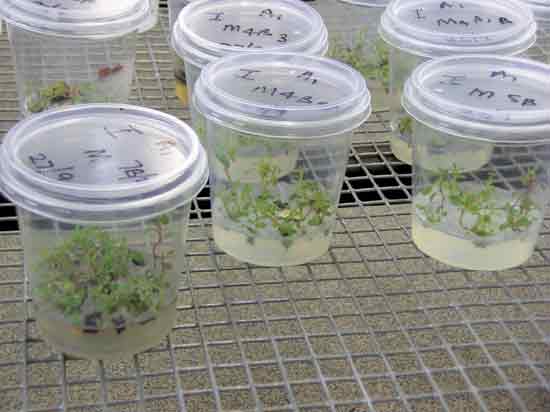
|
|
Figure 5:
Rhododendron
macabeanum
responding to micropropagation.
Photo by Ian Wright |
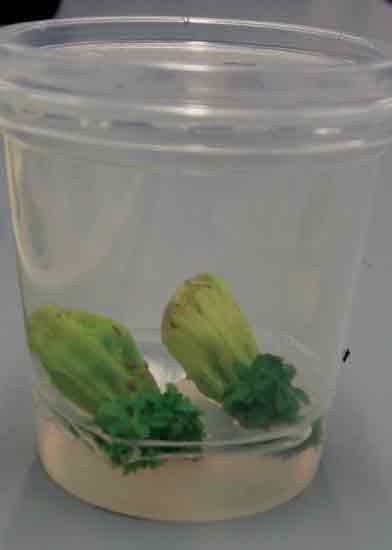
|
|
Figure 6:
Rhododendron macabeanum
growth response
from floral tissue, which seems to be a better option for culturing this particular plant. Photo by Ian Wright |
Plant Suitabilities for Cultivation
Plant material that has matured in vivo (i.e., in situ or from the plant of origin) is
typically unsuitable for micropropagation since total decontamination is virtually
impossible to achieve. It doesn't take long in the outside world for a new graft or
air-layered plant to become riddled with fungal spores, algae and bacteria. To clean
even young garden material may require a concentration of sterilant so high it may
prove phytotoxic. This is especially relevant in the protected microclimates that
occur in old gardens.
When trying to save an old specimen, such as the original introduction of R. macbeanum , then rather than air layering or grafting old stock outside to get more clones, it is better to take a new bud or other appropriate tissue from the old plant and culture it in an environment where it is unlikely to become infected, such as in a greenhouse. When an already infected plant is involved, though, you have no choice but to do in vitro culture from the start to ensure no infection in the new plants that result. The ideal source is thus always from young healthily container frown plants from within a protective environment greenhouse. Unfortunately, without known-to-be-clean stock plants, older plants are often the only propagation material available for much of the year. Another concern is that ancient plants often demonstrate a gradual decrease in vigour as they age; the rate of growth in material taken from a plant of 10-20 years is better than that from plants aged over 150 years.
Outbreaks of PR and PK have mainly as a broad rule been identified only on medium- to smaller-leaved rhododendrons, types such as R. 'Fragrantissimum', R. 'Golden Oriole', R. 'Temple Belle' and the various ponticum hybrids. There have been some infections of Loderi types though, so it should be realized that there is a risk that some larger-leafed species can be susceptible, especially where a large build up of disease occurs.
Bio Security. 'Protecting Ourselves and Others'
The National Trust is developing Bio Security protocols which are to intended to be
implemented at all their 220 gardens to help lessen the risk of introducing new pests
and diseases to their properties. It is also currently surveying heritage plant
collections, an outcome of which will be the identification of their most important
plants and their propagation and safeguarding for the future.
Taken alone, plants account for much of the content, character, significance and appeal of individual gardens. The National Trust manages 25 major plant collections and 32 national collections under the auspices of the National Council for the Conservation of Plants and Gardens. The importance of the Trust's collections to world wide biodiversity has been recognised, and they have been invited to join both the Global Strategy for Plant Conservation as it relates to cultivated plants, and Plant-Collections, a global plant data sharing and conservation cooperation project. They recognise that plant conservation responsibilities are wide, various and have a local, regional and global reach.
Why the need for Bio Security?
(a) Increased globalisation of plant trade
World trade in plants is increasing. In 2005, £870 million ($US 1,250 million)
was spent on imported plants by the British public alone, three times as much as
in 1988. This trade increases the risk of moving plant pests and pathogens around
the World. Plants are sourced from an increasing number of countries, not only to
provide a wider range of often exotic species but also to take advantage of favourable
growing conditions and often cheaper production costs. There is also an increasing
demand from consumers for instant landscapes. This often involves the importation
of large specimen trees, some of which can come complete with their own epiphytic
ecosystems.
(b) Climate change
Warming associated with climate change increases the likelihood that insect
pests in particular will survive and establish in areas normally assumed to
be too cold or not favourable for their survival. In addition, the predicted
increase in summer rainfall and winds in the UK can be favourable to the spread
of pathogens, such as
Phytophthora
species.
Although the initial driver for the project was the impact of two
Phytophthora
diseases on the Trust's gardens, the lessons learnt and the measures proposed are of
generic benefit across the increasing number of pests and pathogens that threaten
the Trust's gardens and landscapes. The following guidelines are set out with this
in mind:
• Set up a Quarantine area for incoming plants.
• Get to know the source nursery.
• Monitor any incoming plants health for at least a month.
• Limit access, designate separate tools, restrict water run off, exclude animals
and birds.
• Plan ahead when buying to plant.
(c) Infection disperal via soil carried on footwear, vehicles, machinery or animals
At infected sites:
• Wash and disinfect, boots, etc. Advise garden staff to leave work footwear at
the garden when leaving the site if possible.
• Liaise with people that go 'off track', such as shooting groups or hikers, who then
want to enter or leave the garden, advising them of the risk posed of spreading spores.
• Restrict animal and people access to away from any infected areas. Keep dogs on short leads,
people on paths, etc.
'Good hygiene is a key way to effective disease control':
• Clean all tools at the end of an operation or when moving from area to area.
• Wash, then disinfect. Make all staff, volunteers and contractors aware of their responsibility
to maintain proper hygiene on site.
• Restrict run off after washing tools.
• Use separate tools when working between clean and infected areas.
• Over watering may risk spreading disease via the excess runoff.
• Recognise that recycled water or rainwater taken from infected sites can pose a risk.
• Ensure plants are not standing in water.
• Use overhead irrigation in a controlled measured way.
• Regularly check hose pipes for leaks.
Other Considerations!
We need to consider other factors before removing large infected plants since:
• Bats frequently navigate between large mature plantings, to and from feeding grounds.
• Disturbance and change to local environmental conditions may affect the reproductive
success and habits of nesting birds, etc.
• Plant removal may disturb valuable archaeological remains.
What Can We All Do to Minimise Infection spread?
• Become familiar with
P. ramorum
and other pests and diseases and their symptoms.
• Create a Quarantine area (in larger gardens) or at least hold back and monitor the health of
arriving plants before planting out.
• Stay vigilant, review your garden hygiene operations and keep up to date with new guidance.
• Identify and record your most important/rare plants, and then propagate and safeguard them.
• Review and improve plant husbandry as necessary.
The UK government has just committed to funding a 5-year disease management program committing
around £25 million. The National Trust has been lobbying the UK government agencies to consider:
• Adequate funding to continue research into the distribution, management and genetic makeup of
these two plant diseases.
• Adequate resources for stringent inspection of plants coming into the country.
• Increased funding for the clearance of infected and non-infected
Rhododendron ponticum
(major host and invasive species) throughout the UK.
• The formation of an Industry Working Party for Botanic and Heritage Gardens to discuss
Phytophthora
and other issues.
Many
Phytopthora
(in fact possibly still a majority) and other pests and diseases are
likely yet to be discovered. Some may well be significantly aggressive to native plant communities
or ornamental plant collections that have not evolved to cope with these new threats. As a
consequence, our preparation and responsibility shouldn't be confined to country borders, as a
disease of any kind will not recognise or stop at a barrier or a fence, and we should not
expect others to action for us. We can all lessen the extent in which pests and diseases use
the pathways we have created by often the simplest actions, without increasing costs or
restricting access and availability to the exciting wider world of plants.
I recently was fortunate to be invited to visit and talk to interested groups in the Vancouver area of British Columbia, Canada, as guests of local ARS Chapters and the B C Nursery and Landscaping Association. While it would have been nice to talk about a more positive subject, I took great heart in the fact that they also recognise the need to share our knowledge, experiences and skills and for us all to learn together as one. This is one of the benefits of the smaller, more accessible world in which we live today!
Is This the End of Rhododendrons?
No, I think not, but we must all work together sharing our experiences and being more responsible
for our actions. Treat
P. ramorum
not as a negative but as an opportunity to work together
to try and share new ideas to overcome this problem. Remember, we have had to overcome challenges
before and we no doubt will have new challenges ahead too! In The National Trust, I feel we have
turned the corner from being solely reactive and are now utilising a better, more proactive
approach.
Background About The National Trust
The National Trust is a UK charity formed over 100 years ago to "Promote the permanent preservation
for the benefit of the nation of sites of beauty and or historic interest, 'forever for everyone'."
The National Trust now cares for over 220 gardens and 100 landscape parks throughout England,
Wales and Northern Ireland, and is one of the largest collection of gardens under one ownership in
the world! The gardens range from the 14th century to the 20th century - 700 years of garden
history, including some internationally renowned gardens such as Hidcote, Bodnant, Stourhead, Powis
and Sheffield Park. The National Trust owns nearly 260,000 ha (650,000 acres) of countryside and
manages hundreds of woods extending to 25,000 ha (61,776 acres) across England, Wales and Northern
Ireland.
The author can be contacted at: Ian Wright, Gardeners Cottage, Trengwainton,, Madron, Penzance, Cornwall, UK TR20 8RZ
